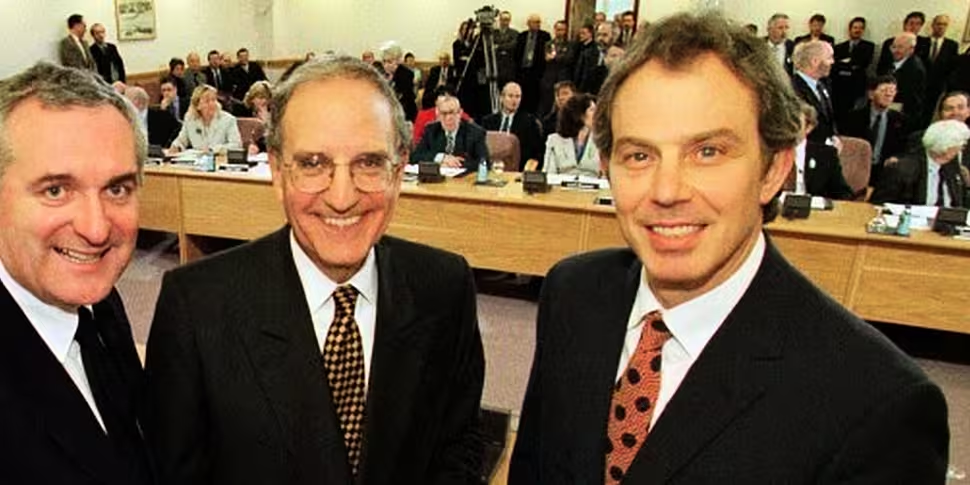This week marks the 20th anniversary of the signing of the Good Friday Agreement.
The landmark 35-page deal brought about a promised end to the violence of the Troubles in Northern Ireland.
The future of the treaty has been thrust back into the spotlight as Britain prepares to leave the European Union.
Issues over the border between the Republic of Ireland and the North have come under increased scrutiny.
While the very structures it created to allow for power-sharing at Stormont have now been idle for over a year.
Events have taken place in Washington and New York to mark the historic peace treaty.
Then-Minister of State Liz O'Donnell (1st left), from the Progressive Democrats wipes away a tear as she tells journalists it is a historic day, as it becomes obvious that a peace deal is almost on the table in Castle Buildings, Belfast in 1998 | Image: Eamonn Farrell/RollingNews.ie
And on Tuesday, the actual date of the agreement, former US President Bill Clinton and former US Senator George Mitchell - who helped broker the deal - are due to accept the Freedom of Belfast at an event in the city.
Speaking to the BBC on Sunday, Senator Mitchell said: "I believe that the single most important result of the Good Friday Agreement has been 20 years of peace, and surely no one would disagree with that.
"Thousands of people who otherwise might have been killed are still alive today as a consequence of the courage and vision of the political leaders of Northern Ireland - and of the UK and Ireland - back in 1998 when they reached this agreement".
What is the Good Friday Agreement?
The Good Friday Agreement is described as a cornerstone of commitment to peace and stability on this island. It was agreed on April 10th 1998 and overwhelmingly approved in two referendums in both parts of Ireland in May 1998.
Constitutional status
The Good Friday Agreement gives prominence to the 'principle of consent' - which affirms the legitimacy of the aspiration to a United Ireland, while recognising the current wish of the majority in Northern Ireland to remain part of the United Kingdom.
The agreement states: "It is for the people of Ireland alone, by agreement between the two parts respectively and without external impediment, to exercise their right of self-determination on the basis of consent, freely and concurrently given, North and South, to bring about a United Ireland, accepting that this right must be achieved and exercised with and subject to the agreement and consent of a majority of the people of Northern Ireland".
Political institutions
The agreement put in place a framework to establish a number of political institutions.
This framework is made up of three strands:
- The Northern Ireland Assembly and Executive: Set up so that the elected political parties could share power. The assembly is located at Stormont
- The North South Ministerial Council: Set up to develop co-operation between both parts of Ireland
- The British-Irish Council: Set up to promote the relationship between Ireland and Britain
These devolved institutions only operated intermittently in the years immediately following the agreement.
The then-deputy leader of the Ulster Unionist Party John Taylor arrives for the final day of the peace talks in Castle Buildings in Belfast in 1998 | Image: Eamonn Farrell/RollingNews.ie
Policing and justice
In 2005, the Independent Decommissioning Body confirmed that IRA decommissioning had taken place.
In 2006, the St Andrew's Agreement was published, which set out a path to full devolution of policing and justice and a stable power-sharing arrangement.
In 2010, the signing of the Hillsborough Agreement allowed for the devolution of policing and justice powers to the Northern Ireland Assembly, which then began later that year.
It also included an agreement on controversial parades which had caused ongoing conflict between communities.
The Stormont House Agreement
In 2014, the Irish and British governments - together with the Northern Ireland Executive parties - took part in 11 weeks of political talks, resulting in the Stormont House Agreement on December 23rd 2014.
The Stormont House Agreement covers a broad range of political, social and economic issues and has the potential to advance aims of reconciliation and economic renewal in Northern Ireland.
The Irish Government also undertook a number of financial commitments, as did the UK government.
The then-Secretary of State for Northern Ireland Dr Mo Mowlam in upbeat mood as she arrives for the final day of the peace talks in Stormont Castle in 1998 | Image: Eamonn Farrell/RollingNews.ie
A Fresh Start: The Stormont Agreement and Implementation Plan
After 10 weeks of talks which began on September 8th, A Fresh Start - The Stormont Agreement and Implementation Plan was agreed on November 17th 2015.
The agreement addressed implementation of many aspects of the Stormont House Agreement, along with the additional issue of tackling the continuing impact and legacy of paramilitarism.
But it was not possible to reach agreement on the implementation of the provisions of the Stormont house Agreement dealing with the legacy of the past within the timescale of the most recent talks.
The Irish and British governments have committed to continue working on this issue with a view to securing an agreed basis for the establishment of the new institutional framework for dealing with the past.
The Foreign Affairs Minister and the Secretary of State for Northern Ireland are responsible for convening quarterly review meetings of the Fresh Start and Stormont House Agreements.
You can read the full text of the Good Friday Agreement here
Additional reporting: Teena Gates












